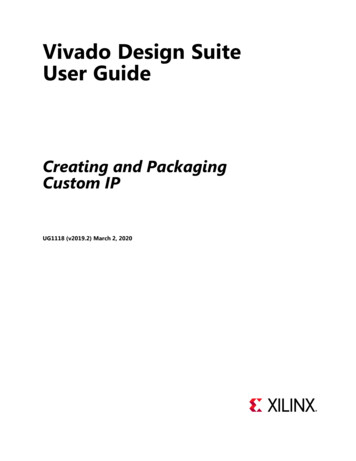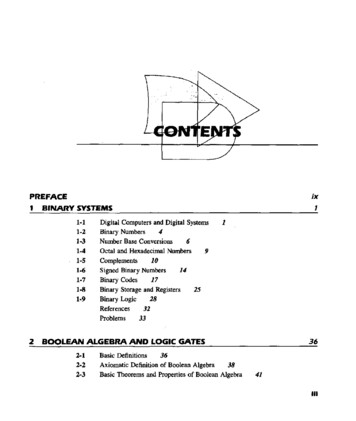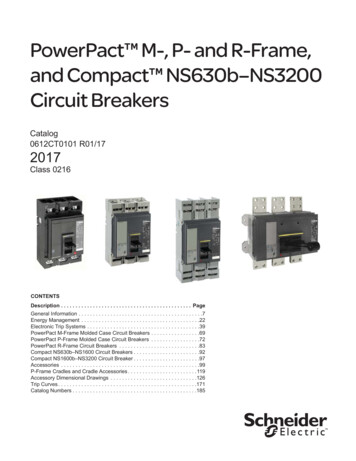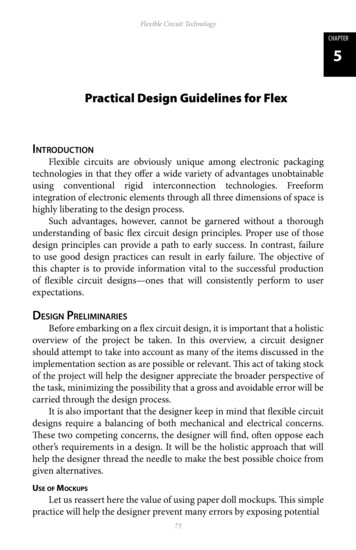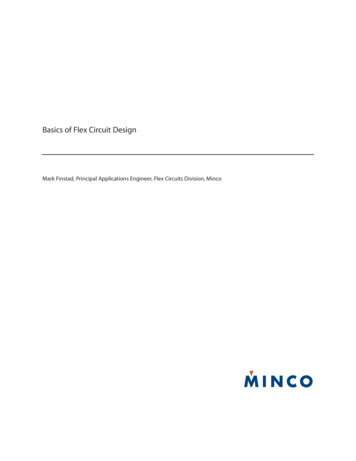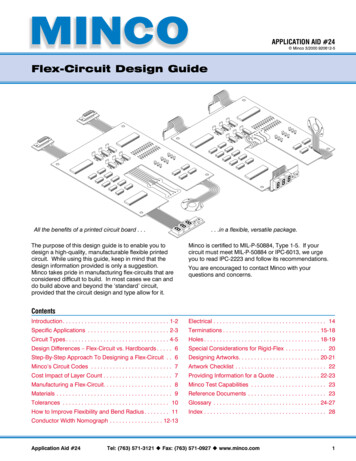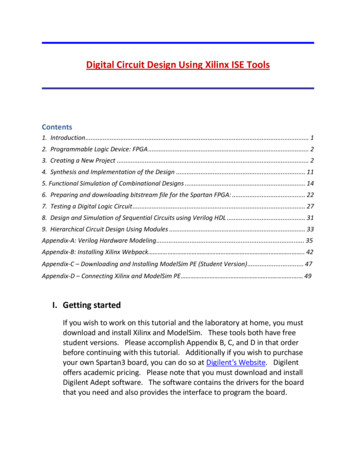
Transcription
Digital Circuit Design Using Xilinx ISE ToolsContents1. Introduction . 12. Programmable Logic Device: FPGA . 23. Creating a New Project . 24. Synthesis and Implementation of the Design . 115. Functional Simulation of Combinational Designs . 146. Preparing and downloading bitstream file for the Spartan FPGA: . 227. Testing a Digital Logic Circuit . 278. Design and Simulation of Sequential Circuits using Verilog HDL . 319. Hierarchical Circuit Design Using Modules . 33Appendix-A: Verilog Hardware Modeling. 35Appendix-B: Installing Xilinx Webpack . . 42Appendix-C – Downloading and Installing ModelSim PE (Student Version). 47Appendix-D – Connecting Xilinx and ModelSim PE . 49I. Getting startedIf you wish to work on this tutorial and the laboratory at home, you mustdownload and install Xilinx and ModelSim. These tools both have freestudent versions. Please accomplish Appendix B, C, and D in that orderbefore continuing with this tutorial. Additionally if you wish to purchaseyour own Spartan3 board, you can do so at Digilent’s Website. Digilentoffers academic pricing. Please note that you must download and installDigilent Adept software. The software contains the drivers for the boardthat you need and also provides the interface to program the board.
1. IntroductionXilinx Tools is a suite of software tools used for the design of digital circuits implementedusing Xilinx Field Programmable Gate Array (FPGA) or Complex Programmable LogicDevice (CPLD). The design procedure consists of (a) design entry, (b) synthesis andimplementation of the design, (c) functional simulation and (d) testing and verification. Digitaldesigns can be entered in various ways using the above CAD tools: using a schematic entry tool,using a hardware description language (HDL) – Verilog or VHDL or a combination of both. Inthis lab we will only use the design flow that involves the use of Verilog HDL.The CAD tools enable you to design combinational and sequential circuits starting with VerilogHDL design specifications. The steps of this design procedure are listed below:1. Create Verilog design input file(s) using template driven editor.2. Compile and implement the Verilog design file(s).3. Create the test-vectors and simulate the design (functional simulation) without using aPLD (FPGA or CPLD).4. Assign input/output pins to implement the design on a target device.5. Download bitstream to an FPGA or CPLD device.6. Test design on FPGA/CPLD deviceA Verilog input file in the Xilinx software environment consists of the following segments:Header: module name, list of input and output ports.Declarations: input and output ports, registers and wires.Logic Descriptions: equations, state machines and logic functions.End: endmoduleAll your designs for this lab must be specified in the above Verilog input format. Note that thestate diagram segment does not exist for combinational logic designs.2. Programmable Logic Device: FPGAIn this lab digital designs will be implemented in the Basys2 board which has a Xilinx Spartan3E–XC3S250E FPGA with CP132 package. This FPGA part belongs to the Spartan family of FPGAs.These devices come in a variety of packages. We will be using devices that are packaged in 132pin package with the following part number: XC3S250E-CP132. This FPGA is a device with about50K gates. Detailed information on this device is available at the Xilinx website.3. Creating a New ProjectXilinx Tools can be started by clicking on the Project Navigator Icon on the Windows desktop.This should open up the Project Navigator window on your screen. This window shows (seeFigure 1) the last accessed project.
Figure 1: Xilinx Project Navigator window (snapshot from Xilinx ISE software)3.1 Opening a projectSelect File- New Project to create a new project. This will bring up a new project window(Figure 2) on the desktop. Fill up the necessary entries as follows:
Figure 2: New Project Initiation window (snapshot from Xilinx ISE software)Project Name:Write the name of your new projectProject Location: The directory where you want to store the new project (Note: DO NOTspecify the project location as a folder on Desktop or a folder in the Xilinx\bin directory.Your H: drive is the best place to put it. The project location path is NOT to have any spacesin it eg: C:\Nivash\TA\new lab\sample exercises\o gate is NOT to be used)Leave the top level module type as HDL.Example: If the project name were “o gate”, enter “o gate” as the project name and then click“Next”.Clicking on NEXT should bring up the following window:
Figure 3: Device and Design Flow of Project (snapshot from Xilinx ISE software)For each of the properties given below, click on the ‘value’ area and select from the list ofvalues that appear.o Device Family: Family of the FPGA/CPLD used. In this laboratory we will be usingthe Spartan3E FPGA’s.o Device: The number of the actual device. For this lab you may enter XC3S250E(this can be found on the attached prototyping board)o Package: The type of package with the number of pins. The Spartan FPGA used inthis lab is packaged in CP132 package.o Speed Grade: The Speed grade is “-4”.o Synthesis Tool: XST [VHDL/Verilog]o Simulator: The tool used to simulate and verify the functionality of the design.Modelsim simulator is integrated in the Xilinx ISE. Hence choose “Modelsim-XEVerilog” as the simulator or even Xilinx ISE Simulator can be used.o Then click on NEXT to save the entries.All project files such as schematics, netlists, Verilog files, VHDL files, etc., will be stored in asubdirectory with the project name. A project can only have one top level HDL source file (orschematic). Modules can be added to the project to create a modular, hierarchical design (seeSection 9).In order to open an existing project in Xilinx Tools, select File- Open Project to show the list ofprojects on the machine. Choose the project you want and click OK.
Clicking on NEXT on the above window brings up the following window:Figure 4: Create New source window (snapshot from Xilinx ISE software)If creating a new source file, Click on the NEW SOURCE.3.2 Creating a Verilog HDL input file for a combinational logic designIn this lab we will enter a design using a structural or RTL description using the Verilog HDL. Youcan create a Verilog HDL input file (.v file) using the HDL Editor available in the Xilinx ISE Tools(or any text editor).In the previous window, click on the NEW SOURCEA window pops up as shown in Figure 4. (Note: “Add to project” option is selected by default. Ifyou do not select it then you will have to add the new source file to the project manually.)
Figure 5: Creating Verilog-HDL source file (snapshot from Xilinx ISE software)Select Verilog Module and in the “File Name:” area, enter the name of the Verilog source fileyou are going to create. Also make sure that the option Add to project is selected so that thesource need not be added to the project again. Then click on Next to accept the entries. Thispops up the following window (Figure 5).Figure 6: Define Verilog Source window (snapshot from Xilinx ISE software)
In the Port Name column, enter the names of all input and output pins and specify theDirection accordingly. A Vector/Bus can be defined by entering appropriate bit numbers in theMSB/LSB columns. Then click on Next to get a window showing all the new sourceinformation (Figure 6). If any changes are to be made, just click on Back to go back and makechanges. If everything is acceptable, click on Finish Next Next Finish to continue.Figure 7: New Project Information window(snapshot from Xilinx ISE software)Once you click on Finish, the source file will be displayed in the sources window in the ProjectNavigator (Figure 1).If a source has to be removed, just right click on the source file in the Sources in Projectwindow in the Project Navigator and select Remove in that. Then select Project - DeleteImplementation Data from the Project Navigator menu bar to remove any related files.3.3 Editing the Verilog source fileThe source file will now be displayed in the Project Navigator window (Figure 8). The sourcefile window can be used as a text editor to make any necessary changes to the source file. All
the input/output pins will be displayed. Save your Verilog program periodically by selecting theFile- Save from the menu. You can also edit Verilog programs in any text editor and add themto the project directory using “Add Copy Source”.Figure 8: Verilog Source code editor window in the Project Navigator (from Xilinx ISE software)Adding Logic in the generated Verilog Source code template:A brief Verilog Tutorial is available in Appendix-A. Hence, the language syntax andconstruction of logic equations can be referred to Appendix-A.The Verilog source code template generated shows the module name, the list of portsand also the declarations (input/output) for each port. Combinational logic code can beadded to the verilog code after the declarations and before the endmodule line.For example, an output z in an OR gate with inputs a and b can be described as,assign z a b;Remember that the names are case sensitive.Other constructs for modeling the logic function:
A given logic function can be modeled in many ways in verilog. Here is another examplein which the logic function, is implemented as a truth table using a case statement:module or gate(a,b,z);input a;input b;output z;reg z;always @(a or b)begincase ({a,b})00: z 1'b0;01: z 1'b1;10: z 1'b1;11: z 1'b1;endcaseendendmoduleSuppose we want to describe an OR gate. It can be done using the logic equation as shown inFigure 9a or using the case statement (describing the truth table) as shown in Figure 9b. Theseare just two example constructs to design a logic function. Verilog offers numerous suchconstructs to efficiently model designs. A brief tutorial of Verilog is available in Appendix-A.Figure 9: OR gate description using assign statement (snapshot from Xilinx ISE software)
Figure 10: OR gate description using case statement (from Xilinx ISE software)4. Synthesis and Implementation of the DesignThe design has to be synthesized and implemented before it can be checked for correctness, byrunning functional simulation or downloaded onto the prototyping board. With the top-levelVerilog file opened (can be done by double-clicking that file) in the HDL editor window in theright half of the Project Navigator, and the view of the project being in the Module view , theimplement design option can be seen in the process view. Design entry utilities and GenerateProgramming File options can also be seen in the process view. The former can be used toinclude user constraints, if any and the latter will be discussed later.To synthesize the design, double click on the Synthesize Design option in the Processeswindow.To implement the design, double click the Implement design option in the Processes window.It will go through steps like Translate, Map and Place & Route. If any of these steps could notbe done or done with errors, it will place a X mark in front of that, otherwise a tick mark will beplaced after each of them to indicate the successful completion. If everything is donesuccessfully, a tick mark will be placed before the Implement Design option. If there are
warnings, one can see mark in front of the option indicating that there are some warnings.One can look at the warnings or errors in the Console window present at the bottom of theNavigator window. Every time the design file is saved; all these marks disappear asking for afresh compilation.Figure 11: Implementing the Design (snapshot from Xilinx ISE software)The schematic diagram of the synthesized verilog code can be viewed by double clicking ViewRTL Schematic under Synthesize-XST menu in the Process Window. This would be a handy wayto debug the code if the output is not meeting our specifications in the proto type board.By double clicking it opens the top level module showing only input(s) and output(s) as shownbelow.
Figure 12: Top Level Hierarchy of the designBy double clicking the rectangle, it opens the realized internal logic as shownbelow.
Figure 13: Realized logic by the XilinxISE for the verilog code5. Functional Simulation of Combinational Designs5.1 Adding the test vectorsTo check the functionality of a design, we have to apply test vectors and simulate the circuit.In order to apply test vectors, a test bench file is written. Essentially it will supply all theinputs to the module designed and will check the outputs of the module. Example: For the 2input OR Gate, the steps to generate the test bench is as follows:In the Sources window (top left corner) right click on the file that you want to generate thetest bench for and select ‘New Source’Provide a name for the test bench in the file name text box and select ‘Verilog test fixture’among the file types in the list on the right side as shown in figure 11.Figure 14: Adding test vectors to the design (snapshot from Xilinx ISE software)Click on ‘Next’ to proceed. In the next window select the source file with which you want toassociate the test bench.
Figure 15: Associating a module to a testbench (snapshot from Xilinx ISE software)Click on Next to proceed. In the next window click on Finish. You will now be provided with atemplate for your test bench. If it does not open automatically click the radio button next toSimulation .You should now be able to view your test bench template. The code generated would besomething like this:module o gate tb v;// Inputsreg a;
reg b;// Outputswire z;// Instantiate the Unit Under Test (UUT)o gate uut (.a(a),.b(b),.z(z));initial begin// Initialize Inputsa 0;b 0;// Wait 100 ns for global reset to finish#100;// Add stimulus hereendendmoduleThe Xilinx tool detects the inputs and outputs of the module that you are going to test and
assigns them initial values. In order to test the gate completely we shall provide all the differentinput combinations. ‘#100’ is the time delay for which the input has to maintain the currentvalue. After 100 units of time have elapsed the next set of values can be assign to the inputs.Complete the test bench as shown below:module o gate tb v;// Inputsreg a;reg b;// Outputswire z;// Instantiate the Unit Under Test (UUT)o gate uut (.a(a),.b(b),.z(z));initial begin// Initialize Inputsa 0;b 0;
// Wait 100 ns for global reset to finish#100;a 0;b 1;// Wait 100 ns for global reset to finish#100;a 1;b 0;// Wait 100 ns for global reset to finish#100;a 1;b 1;// Wait 100 ns for global reset to finish#100;endendmoduleSave your test bench file using the File menu.5.2 Simulating and Viewing the Output WaveformsNow under the Processes window (making sure that the testbench file in the Sources windowis selected) expand the ModelSim simulator Tab by clicking on the add sign next to it. DoubleClick on Simulate Behavioral Model. You will probably receive a complier error. This is nothing
to worry about – answer “No” when asked if you wish to abort simulation. This should causeModelSim to open. Wait for it to complete execution. If you wish to not receive the compilererror, right click on Simulate Behavioral Model and select process properties. Mark thecheckbox next to “Ignore Pre-Complied Library Warning Check”.Figure 16: Simulating the design (snapshot from Xilinx ISE software)5.3 Saving the simulation resultsTo save the simulation results, Go to the waveform window of the Modelsim simulator, Click onFile - Print to Postscript - give desired filename and location.Note that by default, the waveform is “zoomed in” to the nanosecond level.controls to display the entire waveform.Use the zoomElse a normal print screen option can be used on the waveform window and subsequentlystored in Paint.
Figure 17: Behavioral Simulation output Waveform (Snapshot from ModelSim)For taking printouts for the lab reports, convert the black background to white in Tools - EditPreferences. Then click Wave Windows - Wave Background attribute.
Figure 18: Changing Waveform Background in ModelSim
6. Preparing and downloading bitstream file for the Spartan FPGA:A bitstream file needs to be prepared for each design and downloaded onto the Basys2prototyping board. This is done as follows:User Constraint File:o In order to test the design in the Basys2 board, the inputs need to be connected tothe switches/buttons on the board and the outputs need to be connected to theonboard LED’s.o To create the constraint file, ensure that the implementation radio button isselected and your verilog module is highlighted. In the processes window, expandUser Constraints and double click on I/O Pin Planning (Plan Ahead) Post Synthesis.Answer “Yes” when asked if you want to create the UCF file. This will create theconstraint file but also open the Plan Ahead application. It is beyond the scope ofthis tutorial to cover Plan Ahead. Wait for the Plan Ahead to fully open, then closeit. You will now see the .ucf file in your hierarchy. Double click it to edit the file.o Assign pin numbers to the input and output pins in the Verilog design file using a“User Constraint File(ucf file)”. The pin numbers can be assigned by looking atsection 7 of this tutorial. Then save the design file and implement the design again.Note that you can assign pin numbers only to top-level Verilog file. Then theProject Navigator window looks as shown in Figure 13.Figure 19: User Constraint File (snapshot from Xilinx ISE software)
For the OR GATE example, the user constraint file used is as follows:#Balls P11 and L3 of FPGA are connected to SW0 and SW1 in Basys2 Board andBall M5 of FPGA is connected to LED0 in Basys2 Board.# OR Gate Constraint list - CommentNET a LOC "P11";NET b LOC "L3";NET z LOC "M5";In the Sources View, choose the main design file and in the Process View - UserConstraints – Edit Constraints option, add the user constraint file for the design.Then, in the Process View window (left-bottom), double click on the ‘GenerateProgramming file’.6.1 Programming the DeviceOnce the programming file (bit stream file) is generated, the file has to be downloaded to theSpartan3 device. This is done by using another application Adept provided by Digilent Inc.,Connect the Demo board to the PC using the USB extension cable. Connect the USB-Type Aconnector to PC and Mini-AB end to the demo board.Click and Go to Start - All Programs - Digilent - Adept - Adept
Figure 20: Adept Opening screen after connecting FPGA boardIf the board is working properly it should show the above information which is highlighted bythe red color box. If it is not showing there might be problems with the board and/or the cable.To download the program, click on Browse command in the first Row which says FPGA(XC3S250E). Browse to the project folder and choose the corresponding bit file as shown belowand click open.
Figure 21: Choosing the bit stream file to downloadOnce this is done, a warning window will pop up if the clock is set to CCLK which can be closedby clicking Yes as shown below. Or it can be fixed by setting Clock source to JTAG Clock in theSynthesize setting in XilinxISE.Figure 22: Warning about CCLK and JTAG CLKNow click on the Program button to program the FPGA and if it successfully programming thefollowing information should show up in the status window.
Figure 23: Showing the programming statusEnsure that the “Programming Successful” message appears in the message window.
7. Testing a Digital Logic CircuitTesting a downloaded design requires connecting the inputs of the design to switches or portsand the outputs of the design to LEDs or 7-segment displays. In case of sequential circuits, theclock input(s) must also be connected to clock sources. These inputs and outputs can beconnected to appropriately on the Digital Lab workbench.The Basys2 Board used in the Digital Circuits lab has the following features which can be used totest the digital logic in the design:1.2.3.4.8 Switches-- which can be used to drive up to 8 inputs4 Buttons-- which can be used as reset signals (or) input switches8 LEDs -- which can be used to display up to 8 design outputs4 Seven segment displays-- which can be used to display four digits ofinformation in the display on the boardFigure 24: Basys2 Architecture (Source: www.digitalinc.com)In order to use the respective input/output device on the board, the pin number of the devicemust be connected properly to the design’s input/output. In the Basys2 board, the pin numberof these inputs/outputs is as follows:InputSwitchFPGA Ball(To be used in the ucffile)SW0pin# P11SW1pin# L3SW2pin# K3SW3pin# B4
ButtonSW4pin# G3SW5pin# F3SW6pin# E2SW7pin# N3BTN0pin# G12BTN1pin# C11BTN2pin# M4BTN3pin# A7Yet to ChangeInputClock(for sequential designsGLK1pin# P77GCLK2pin# P182FPGA Pin(To be used in the ucffile)OutputLEDFPGA Pin(To be used in the ucffile)LD0pin# M5LD1pin# M11LD2pin# P7LD3pin# P6LD4pin# N5LD5pin# N4LD6pin# P4LD7Pin# G17.1 Observing outputs using the on-board LEDs and Seven Segment DisplaysThe Basys2 boards have four on-board 7-segment displays (see Figure 19) that is connected tothe corresponding on-board Spartan FPGA chip. This display can be used to observe the outputsof your design without using any additional wires if the design conforms to the pin assignmentsfor the on-board 7-segment display. The figure below shows the 7-segment display with the
conventional labeling of individual segments.Figure 25: 7 Segment DisplayThe Basys2 board contains a 4-digit common anode seven-segment LED display. The display ismultiplexed, so only seven cathode signals(CA,CB,CC,CD,CE,CF,CG) exist to drive all 28 segmentsin the display. Four digit-enable signals(AN1,AN2,AN3,AN4) drive the common anodes, andthese signals determine which digit the cathode signals illuminate.OutputLED Anode(To be used toMultiplex betweenFour Displays)LED CathodeFPGA Pin(To be used in the ucffile)AN0pin# F12AN1pin# J12AN2pin# M13AN3pin# K14CApin# L14CBpin# H12CCpin# N14CDpin# N11CEpin# P12CFpin# L13CGpin# M12DPPin# N13This connection scheme creates a multiplexed display, where driving the anode signals andcorresponding cathode patterns of each digit in a repeating, continuous succession can createthe appearance of a 4-digit display. Each of the four digits will appear bright and continuouslyilluminated if the digit enable signals are driven low once every 1 to 16ms (for a refreshfrequency of 1KHz to 60Hz).The Seven segment display timing to drive all the four displays is shown below:
Figure 26: Timing diagram for Multiplexed Seven Segment Displays
8. Design and Simulation of Sequential Circuits using Verilog HDLThe procedure to create Verilog design files for sequential circuits in Xilinx ISE is the same asthat for combinational circuits. The main difference between combinational and sequentialdesigns is the presence of flip-flops (registered outputs or nodes in the Declaration section of asequential design).8.1 Design of Sequential CircuitsFor large, complex state machines it is easier to specify them as programs. A sequential circuitcan be described either as a procedural block or a state machine in Verilog.1. A D-flip with asynchronous reset can be modeled as a Procedural block as follows:Figure 27: D-Flip flop with Asynchronous Resetmodule dff async (data, clock, reset, q);input data, clock, reset;output q;regq;// logic begins herealways @(posedge clock or negedge reset)if(reset 1'b0)q 1'b0;elseq data;endmodule
2. A D-flip with synchronous reset can be modeled as a Procedural block as follows:Figure 28: D-Flip flop with Synchronous Resetmodule dff sync (data, clock, reset, q);input data, clock, reset;output q;regq;// logic begins herealways @(posedge clock)if(reset 1'b0)q 1'b0;elseq data;endmodule8.2 Simulation of sequential designsExcept for the additional clock signal, simulation of sequential designs can be done usingtest bench in the same way it was done for combinatorial circuits. The clock signal can begenerated in the test bench using a simple initial block as follows:module test bench(clk)output clk;reg clk;initial beginclk 0;forever begin#5 clk clk; //Time period of the clock is 10 time units.end// rest of the logicendmodule
9. Hierarchical Circuit Design Using ModulesIt is always a good practice to keep a design modular and hierarchical. This is important fordesigns of moderate to high complexity. [Refer to section on hierarchies and Instantiation inthe Verilog tutorial in Appendix-A]. Often, you will use a circuit (module) over and over again.Instead of creating these modules every time you need them, it would be more efficient tomake a cell or module out of them. You can then use this module every time to need it byinstantiating the module in your circuit. Verilog supports hierarchical design by creatinginstances of other modules that can be used in a design. In the example depicted in Figure 19, a4-bit equivalence circuit is designed using 1-bit equivalence circuit modules.Figure 29: Hierarchical circuit design example: 4-bit equivalence circuitModule Definition: A module (functional block) definition is specified in a file, separatefrom the top-level design file using the module.module equiv (p,q,r)input p;input q;output r;assign r (p q);endmodule//equivalence function is xnor function.
Module Usage: A design using a module includes a declaration of module interface andinstantiation of each module in the Declaration section. Instantiation of module “equiv”in the 4-bit equivalence circuit shown in Figure.21 can be done as follows:module equiv4bit(a3,b3,a2,b2,a1,b1,a0,b0,eq4)input a3,b3,a2,b2,a1,b1,a0,b0;output eq4;equiv eq0(a0,b0,r0);equiv eq1(a1,b1,r1);equiv eq2(a2,b2,r2);equiv eq3(a3,b3,r3);assign eq4 r0 & r1 & r2 & r3;endmoduleNOTE : For creation of the module, we can either use the design wizard provided by the Xilinx orcreate our own.
Appendix-A:Verilog Hardware Modeling:This is just an introductory level tutorial to the Verilog language. The reader isencouraged to go through the following Verilog tutorials to understand the language better:http://www-ee.eng.hawaii.edu/ .com/ [requires free registration]1. Module:A module is the basic building block in Verilog. It is defined as follows:module module name ( portlist );.// module components.endmoduleThe module name is the type of this module. The portlist is the list of connections, orports, which allows data to flow into and out of modules of this type.Verilog models are made up of modules. Modules, in turn, are made of different types ofcomponents. These includeParametersNetsRegistersPrimitives and InstancesContinuous AssignmentsProcedural BlocksTask/Function definitions2. Ports:Ports are Verilog structures that pass data between two or more modules. Thus, ports canbe thought of as wires connecting modules. The connections provided by ports can beeither input, output, or bi-directional (inout).
Module instantiations also contain port lists. This is the means of connecting signals in theparent module with signals in the child module.3. Nets:Nets are the things that connect model components together. They are usually thought of aswires in a circuit. Nets are declared in statements like this:net type [range] [delay3] list of net identifiers ;Example:wire w1, w2;tri [31:0] bus32;wire wire number 5 wire number 2 & wire number 3;4. Registers:Registers are storage elements. Values are stored in registers in procedural assignmentstatements. Registers can be used as the source for a primitive or module instance (i.e. registerscan be connected to input ports), but they cannot be driven in the same way a net can.Registers are declared in statements like this:reg [range] list of register identifiers ;Example:reg r1, r2;reg [31:0] bus32;
5. Operators in Verilog:Logical, arithmetic and relational operators available in Verilog are described in Table 1.Verilog Unary Operators:Source: ASIC Design by Smith (http://www-ee.eng.hawaii.edu/ msmith/ASICs/Files/pdf/CH11.3.pdf)Table 1 Verilog Operators6. Continuous assignments:Continuous assignments are sometimes known as data flow statements because they describehow data moves from one place, either a net or register, to another. They are usually thought
of as representing combinational logic. In general, any logic functionality which can beimplemented by means of a continuous assignment can also be implemented using primitiveinstances.A continuous assignment looks like this:assign [delay3] list of net assignments ;Examples:assign w1 w2 & w3;assign #1 mynet enable; // mynet is assigned the value after 1 time unit.7. Procedural Blocks:Procedural blocks are the part of the language which represents sequential behavior. A modulecan have as many procedural blocks as necessary. These blocks are sequences of executablestatements. The statements in each block are
implement design option can be seen in the process view. Design entry utilities and Generate Programming File options can also be seen in the process view. The former can be used to include user constraints, if any and the latter will be discussed later. To synthesize the design, double click on the S
